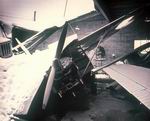| Construction methods
for water and sewage systems also depend on whether he area is underlaid
by permanently frozen ground. In permafrost areas, the distribution systems
should be constructed above ground on supports frozen into the permafrost.
Domestic water should be heated and continuously circulated in insulated
chases, called utilidors. Good sources of fresh water are hard to find
in the frozen north, and there is no completely satisfactory way to dispose
of sewage. Compost toilets can solve the problems of solid wastes; other
waste water can be stored in a holding tank, kept from freezing by the
heated envelope of the building until the spring thaw.
In areas not underlaid with permafrost, the pipes should be placed
in trenches below the active frost line and brought up into the building
inside the insulated footing line. Sewage is less likely to freeze than
domestic water as it contains water already heated to room temperature,
but sewage lines should slope steeply until they reach a disposal site
below the frost.
The areas with the heaviest snowfall or the coldest weather often cope
with snow and cold quite well. The snowiest large cities in the U.S.
are in Minnesota, Michigan, and upstate New York, where storms come
off the Great Lakes. Minneapolis, St. Paul, Calgary, and Edmonton have
"skyways" connecting downtown buildings at the second-story
level so that people can go about their daily business protected from
cold and
snow. Toronto and Montreal accomplish the same purpose with underground
pedestrian systems. The ski resort of Snowmass, Colo., heats the pavement
in its sloping main street, aptly called "Snowmelt Avenue."
In Houghton, Mich., with an annual snowfall of more than 200 inches,
the city built stout steel roofs over the main street, and even these
must be shoveled from time to time.(Figure 13)
The disasters usually occur in areas where heavy snowfall is not expected.
In 1979, a record 88-inch snowfall in northern Illinois resulted in
an estimated 37,327 claims of property damage. In Redding, Calif., in
1968, seven long span buildings collapsed and two others were declared
unsafe and closed after a 23-inch snow- fall was followed by heavy rain
(Figure 14). At that time, the snow load on the roofs in Redding was
calculated as at least 20 pounds per square foot; the city code required
design for only 12 pounds. Even the 1982 ANSI standards show Redding
as having a maximum of five pounds ground snow load from a 50-year storm.
The 300x360-foot Hartford, Conn., Civic Center Coliseum collapsed in
January 1978 under a snow load variously estimated at from II to 18
pounds per square foot, although it was designed to support a snow
load of 30 pounds per square foot. Fortunately, the coliseum was empty
at the time. It has been suggested that the design and/or construction
of the coliseum was faulty, but I feel part of the cause of the collapse
came from a lack of recognition in the building codes of how snow loads
affects structures, especially highly flexible buildings subject to
sizable horizontal forces. This might be called the "inverse pendulum
effect," where the weight of the snow on the roof acts under wind
or earthquake force to amplify the stress in the structure. The 1982
ANSI standards for earthquakes state that "the authority having
jurisdiction may allow the snow load to be reduced up to 75 percent."
Such reductions are common in such places as Redding and Hartford,
where heavy snows are uncommon. I suggest this is a dangerous practice,
and places of public assembly should be designed for at least 80 percent
of the ground snow load; and at least 50 percent of the snow load should
be used in computing the lateral force loading. This is an aspect of
structural design where more investigation is needed. The next failure
of a coliseum may happen when the building is filled to capacity.
None of the codes require a building to withstand a maximum snow load
combined with a maximum wind load or with a maximum earthquake load.
This may make sense for wind loads on buildings with steeply pitched
roofs. Strong winds rarely occur without warning, and the wind itself
tends to strip the snow off the roof prior to reaching maximum intensity.
However, earthquakes cannot be predicted in advance, and the full force
of the shock may take place while a large snow load is on the roof.
Sensitivity to the microclimates and weather history of a particular
site is vital in the cold country. Zermatt, Switzerland, is a beautiful
mountain village that takes full advantage of its special climate. It
is at only 5,000 feet elevation, but it is encircled by giant mountains,
such as the Matterhorn and the Zinal Rothorn, which shadow the town
in the winter except at midday. Although the snowfall in the town itself
is not heavy, there is very little solar melting, and air temperatures
remain cold in the winter.
|



